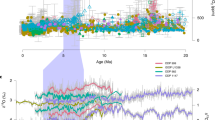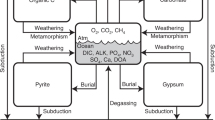Abstract
Environmental niches in which life first emerged and later evolved on the Earth have undergone dramatic changes in response to evolving tectonic/geochemical cycles and to biologic interventions1,2,3, as well as increases in the Sun’s luminosity of about 25 to 30 per cent over the Earth’s history4. It has been inferred that the greenhouse effect of atmospheric CO2 and/or CH4 compensated for the lower solar luminosity and dictated an Archaean climate in which liquid water was stable in the hydrosphere5,6,7,8. Here we demonstrate, however, that the mineralogy of Archaean sediments, particularly the ubiquitous presence of mixed-valence Fe(II–III) oxides (magnetite) in banded iron formations9 is inconsistent with such high concentrations of greenhouse gases and the metabolic constraints of extant methanogens. Prompted by this, and the absence of geologic evidence for very high greenhouse-gas concentrations10,11,12,13, we hypothesize that a lower albedo on the Earth, owing to considerably less continental area and to the lack of biologically induced cloud condensation nuclei14, made an important contribution to moderating surface temperature in the Archaean eon. Our model calculations suggest that the lower albedo of the early Earth provided environmental conditions above the freezing point of water, thus alleviating the need for extreme greenhouse-gas concentrations to satisfy the faint early Sun paradox.
This is a preview of subscription content, access via your institution
Access options
Subscribe to this journal
Receive 51 print issues and online access
$199.00 per year
only $3.90 per issue
Buy this article
- Purchase on Springer Link
- Instant access to full article PDF
Prices may be subject to local taxes which are calculated during checkout


Similar content being viewed by others
References
Canfield, D. E., Rosing, M. T. & Bjerrum, C. Early anaerobic metabolisms. Phil. Trans. R. Soc. B 361, 1819–1834 (2006)
Sleep, N. H. & Bird, D. K. Niches of the pre-photosynthetic biosphere and geologic preservation of Earth’s earliest ecology. Geobiology 5, 101–117 (2007)
Lowe, D. R. & Tice, M. M. Geologic evidence for Archean atmospheric and climatic evolution: fluctuating CO2, CH4, and O2, with an overriding tectonic control. Geology 32, 493–496 (2004)
Gough, D. O. Solar interior structure and luminosity variations. Sol. Phys. 74, 21–34 (1981)
Sagan, C. & Mullen, G. Earth and Mars—evolution of atmospheres and surface temperatures. Science 177, 52–56 (1972)
Kiehl, J. T. & Dickinson, R. E. A study of the radiative effects of enhanced atmospheric CO2 and CH4 on early Earth surface temperatures. J. Geophys. Res. 92, 2991–2998 (1987)
Kasting, J. F. Earth’s early atmosphere. Science 259, 920–926 (1993)
Haqq-Misra, J. D., Domagal-Goldman, S. D., Kasting, P. J. & Kasting, J. F. A. Revised, hazy methane greenhouse for the Archean Earth. Astrobiology 8, 1127–1137 (2008)
Klein, C. & Beukes, N. in Proterozoic Crustal Evolution Vol. 10 Developments in Precambrian Geology (ed. Condie, K. C.) 383–418 (Elsevier, 1992)
Rye, R., Kuo, P. H. & Holland, H. D. Atmospheric carbon-dioxide concentrations before 2.2-billion years ago. Nature 378, 603–605 (1995)
Sleep, N. H. & Zahnle, K. Carbon dioxide cycling and implications for climate on ancient Earth. J. Geophys. Res. Planets 106, 1373–1399 (2001)
Hessler, A. M., Lowe, D. R., Jones, R. L. & Bird, D. K. A lower limit for atmospheric carbon dioxide levels 3.2 billion years ago. Nature 428, 736–738 (2004)
Sheldon, N. D. Precambrian paleosols and atmospheric CO2 levels. Precambr. Res. 147, 148–155 (2006)
Kump, L. R. & Pollard, D. Amplification of cretaceous warmth by biological cloud feedbacks. Science 320, 195 (2008)
Rosing, M. T., Rose, N. M., Bridgwater, D. & Thomsen, H. S. Earliest part of Earth's stratigraphic record: a reappraisal of the >3.7 Ga Isua (Greenland) supracrustal sequence. Geology 24, 43–46 (1996)
Peck, W. H., Valley, J. W., Wilde, S. A. & Graham, C. M. Oxygen isotope ratios and rare earth elements in 3.3 to 4.4 Ga zircons: ion microprobe evidence for high delta O-18 continental crust and oceans in the Early Archean. Geochim. Cosmochim. Acta 65, 4215–4229 (2001)
Catling, D. C., Zahnle, K. J. & McKay, C. P. Biogenic methane, hydrogen escape, and the irreversible oxidation of early Earth. Science 293, 839–843 (2001)
Rossow, W. B., Henderson-sellers, A. & Weinreich, S. K. Cloud feedback—a stabilizing effect for the early Earth. Science 217, 1245–1247 (1982)
Charlson, R. J., Lovelock, J. E., Andreae, M. O. & Warren, S. G. Oceanic phytoplankton, atmospheric sulfur, cloud albedo and climate. Nature 326, 655–661 (1987)
Knauth, L. P. & Lowe, D. R. High Archean climatic temperature inferred from oxygen isotope geochemistry of cherts in the 3.5 Ga Swaziland Supergroup, South Africa. Geol. Soc. Am. Bull. 115, 566–580 (2003)
Tice, M. M. & Lowe, D. R. Photosynthetic microbial mats in the 3,416-Myr-old ocean. Nature 431, 549–552 (2004)
Sleep, N. H. & Hessler, A. M. Weathering of quartz as an Archean climatic indicator. Earth Planet. Sci. Lett. 241, 594–602 (2006)
Jaffres, J. B. D., Shields, G. A. & Wallmann, K. The oxygen isotope evolution of seawater: a critical review of a long-standing controversy and an improved geological water cycle model for the past 3.4 billion years. Earth Sci. Rev. 83, 83–122 (2007)
Kasting, J. F. et al. Paleoclimates, ocean depth, and the oxygen isotopic composition of seawater. Earth Planet. Sci. Lett. 252, 82–93 (2006)
Rye, R. & Holland, H. D. Paleosols and the evolution of atmospheric oxygen: a critical review. Am. J. Sci. 298, 621–672 (1998)
Ohmoto, H., Watanabe, Y. & Kumazawa, K. Evidence from massive siderite beds for a CO2-rich atmosphere before 1.8 billion years ago. Nature 429, 395–399 (2004)
Hoehler, T. M. et al. Comparative ecology of H2 cycling in sedimentary and phototrophic ecosystems. Antonie Van Leeuwenhoek Int. J. Gen. Molec. Microbiol. 81, 575–585 (2002)
Kral, T. A., Brink, K. M., Miller, S. L. & McKay, C. P. Hydrogen consumptions by methanogens on the early Earth. Origins Life Evol. B 28, 311–319 (1998)
Chapelle, F. H. et al. A hydrogen-based subsurface microbial community dominated by methanogens. Nature 415, 312–315 (2002)
Kasting, J. F., Pavlov, A. A. & Siefert, J. L. A coupled ecosystem-climate model for predicting the methane concentration in the archean atmosphere. Origins Life Evol. B 31, 271–285 (2001)
Charecha, P., Kasting, J. & Seifert, J. A coupled atmosphere-ecosystem model of the early Archean Earth. Geobiology 3, 53–76 (2005)
Rosing, M. T. & Frei, R. U-rich Archaean sea-floor sediments from Greenland—indications of > 3700 Ma oxygenic photosynthesis. Earth Planet. Sci. Lett. 217, 237–244 (2004)
Caballero, R. & Steder, M. CliMT: An object-oriented Climate Modelling and diagnostics Toolkit. 〈http://maths.ucd.ie/~rca/climt/〉 (2008)
Johnson, J. W., Oelkers, E. H. & Helgeson, H. C. Supcrt92—a software package for calculating the standard molal thermodynamic properties of minerals, gases, aqueous species, and reactions from 1-bar to 5000-bar and 0-degrees-C to 1000-degrees-C. Comput. Geosci. 18, 899–947 (1992)
Pavlov, A. A., Kasting, J. F., Brown, L. L., Rages, K. A. & Freedman, R. Greenhouse warming by CH4 in the atmosphere of early Earth. J. Geophys. Res. 105, 11981–11990 (2000)
Bjerrum, C. J. & Canfield, D. E. Ocean productivity before about 1.9 Gyr ago limited by phosphorus adsorption onto iron oxides. Nature 417, 159–162 (2002)
Hartmann, D. L. Global Physical Climatology (Academic Press, 1994)
Kump, L. R., Kasting, J. F. & Barley, M. E. Rise of atmospheric oxygen and the “upside-down” Archean mantle. Geochem. Geophys. Geosyst. 2, 2000GC000114 (2001)
Wielicki, B. A. et al. Clouds and the Earth’s radiant energy system (CERES): an Earth observing system experiment. Bull. Am. Meteorol. Soc. 77, 853–868 (1996)
Kiehl, J. T. & Trenberth, K. E. Earth’s annual global mean energy budget. Bull. Am. Meteorol. Soc. 78, 197–208 (1997)
Caldeira, K. & Kasting, J. F. The life-span of the biosphere revisited. Nature 360, 721–723 (1992)
Peixoto, J. P. & Ooort, A. H. Physics of Climate (American Institute of Physics, 1992)
Armstrong, R. L. The persistent myth of crustal growth. Aust. J. Earth Sci. 38, 613–630 (1991)
Wilde, S. A., Valley, J. W., Peck, W. H. & Graham, C. M. Evidence from detrital zircons for the existence of continental crust and oceans on the Earth 4.4 Gyr ago. Nature 409, 175–178 (2001)
Valley, J. W. et al. A cool early Earth. Geology 30, 351–254 (2002)
Mclennan, S. M. & Taylor, S. R. Continental freeboard, sedimentation rates and growth of continental crust. Nature 306, 169–172 (1983)
Collerson, K. D. & Kamber, B. S. Evolution of the continents and the atmosphere inferred from Th-U-Nb systematics of the depleted mantle. Science 283, 1519–1522 (1999)
Nagler, T. F. & Kramers, J. D. Nd isotopic evolution of the upper mantle during the Precambrian: models, data and the uncertainty of both. Precambr. Res. 91, 233–252 (1998)
Condie, K. C. Episodic continental growth models: afterthoughts and extensions. Tectonophysics 322, 153–162 (2000)
Flament, N., Coltice, N. & Rey, P. F. A case for late-Archaean continental emergence from thermal evolution models and hypsometry. Earth Planet. Sci. Lett. 275, 326–336 (2008)
Rey, P. F. & Coltice, N. Neoarchean lithospheric strengthening and the coupling of Earth's geochemical reservoirs. Geology 36, 635–638 (2008)
Acknowledgements
This study was carried out at the Nordic Center for Earth Evolution funded by the Danish National Research Foundation and the research was supported by an Allan C. Cox Professorship to M.T.R. and endowment funds from the Department of Geological and Environmental Sciences from Stanford University to D.K.B., and NSF grants to N.H.S. We are grateful for comments from D. Lowe, D. Canfield, F. Selsis, P. Ditlevsen and the “Ice and climate group” of the Niels Bohr Institute. We thank R. Caballero and J. Bendtsen for comments on the radiation balance model. We thank J. Kasting, A. Lenardic and N. Sheldon for constructive reviews.
Author Contributions All authors have contributed to developing the ideas presented. M.T.R. and D.K.B. carried out the thermodynamic modelling, and C.J.B. carried out the radiative climate modelling, based on surface albedo change (M.T.R.) and low CCN (C.J.B.).
Author information
Authors and Affiliations
Corresponding author
Ethics declarations
Competing interests
The authors declare no competing financial interests.
PowerPoint slides
Rights and permissions
About this article
Cite this article
Rosing, M., Bird, D., Sleep, N. et al. No climate paradox under the faint early Sun. Nature 464, 744–747 (2010). https://doi.org/10.1038/nature08955
Received:
Accepted:
Issue Date:
DOI: https://doi.org/10.1038/nature08955
This article is cited by
-
Solar structure and evolution
Living Reviews in Solar Physics (2021)
-
Is the Faint Young Sun Problem for Earth Solved?
Space Science Reviews (2020)
-
Snowball Earth at low solar luminosity prevented by the ocean–atmosphere coupling
Acta Geochimica (2019)
Comments
By submitting a comment you agree to abide by our Terms and Community Guidelines. If you find something abusive or that does not comply with our terms or guidelines please flag it as inappropriate.



